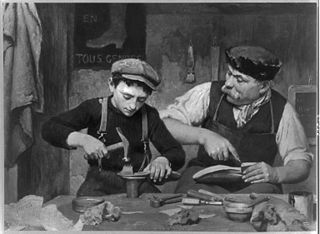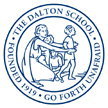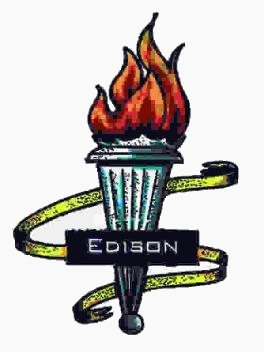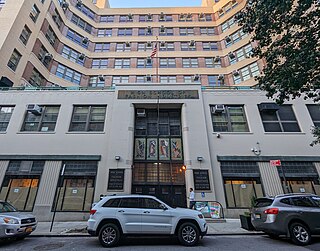Gallery
The following photographs of activities at the Manhattan Trade School for Girls date to 1916:
- Academic class
- Operating department
- Straw sewing
- Art room
The Manhattan Trade School for Girls was a New York City public high school founded in 1902 by Mary Schenck Woolman, [1] and was the first vocational school for female students established in the United States. [2] It was established by philanthropic reformers to provide training for young women to work in trades such as garment factory work. It was originally located on West 14th Street, but was moved to East 23rd Street in 1906–1907. To accommodate growing enrollment, a new building was constructed and designed by C. B. J. Snyder in 1915 at 127 East 22nd Street. [3] The building now houses The School of the Future, a New York City public middle school and high school.
The following photographs of activities at the Manhattan Trade School for Girls date to 1916:
A documentary film was made about the school in 1911. [4] The film is available on DVD from Image Entertainment as part of the box set Treasures III: Social Issues in American Film, 1900–1934 with a ragtime style musical score by Elena Ruehr composed specifically for the film.

Apprenticeship is a system for training a new generation of practitioners of a trade or profession with on-the-job training and often some accompanying study. Apprenticeships can also enable practitioners to gain a license to practice in a regulated occupation. Most of their training is done while working for an employer who helps the apprentices learn their trade or profession, in exchange for their continued labor for an agreed period after they have achieved measurable competencies.

John Woolman was an American merchant, tailor, journalist, Quaker preacher, and early abolitionist during the colonial era. Based in Mount Holly, near Philadelphia, he traveled through the American frontier to preach Quaker beliefs, and advocate against slavery and the slave trade, cruelty to animals, economic injustices and oppression, and conscription. Beginning in 1755 with the outbreak of the French and Indian War, he urged tax resistance to deny support to the colonial military. In 1772, Woolman traveled to England, where he urged Quakers to support abolition of slavery.

A vocational school, trade school, or technical school is a type of educational institution, which, depending on the country, may refer to either secondary or post-secondary education designed to provide vocational education or technical skills required to complete the tasks of a particular and specific job. In the case of secondary education, these schools differ from academic high schools which usually prepare students who aim to pursue tertiary education, rather than enter directly into the workforce. With regard to post-secondary education, vocational schools are traditionally distinguished from four-year colleges by their focus on job-specific training to students who are typically bound for one of the skilled trades, rather than providing academic training for students pursuing careers in a professional discipline. While many schools have largely adhered to this convention, the purely vocational focus of other trade schools began to shift in the 1990s "toward a broader preparation that develops the academic" as well as the technical skills of their students.

The Dalton School, originally the Children's University School, is a private, coeducational college preparatory school in New York City and a member of both the Ivy Preparatory School League and the New York Interschool. The school is located in four buildings within the Upper East Side of Manhattan. In the 2023–24 academic year, tuition rates totaled $61,120.

Thomas A. Edison Career and Technical Education High School is a public secondary school in Queens's Jamaica Hills community in New York City. It is one of the few public high schools in New York City to offer vocational training programs as well as traditional college preparatory tracks and well known for its largely male population. The school is operated by the New York City Department of Education.

Aviation High School, officially named Aviation Career & Technical Education High School (24Q610), is a public high school owned and operated by the New York City Department of Education. Formerly known as the Manhattan School of Aviation Trades (SAT), Aviation High School has operated since 1936. It is in the Long Island City neighborhood of the New York City borough of Queens. The school accepts students from all five boroughs according to the NYC screened school process. The main focus of the school is to train licensed Federal Aviation Administration airframe and powerplant technicians.

The Beaux-Arts Institute of Design was an art and architectural school at 304 East 44th Street in Turtle Bay, Manhattan, in New York City. It was founded in 1916 by Lloyd Warren for the training of American architects, sculptors and mural painters consistent with the educational agenda of the French École des Beaux-Arts. The building is now home to Egypt's mission to the United Nations.

School of the Future is a public secondary school located at 127 East 22nd Street at Lexington Avenue, in the Gramercy Park neighborhood of the borough of Manhattan in New York City. It serves grades 6 through 12 as a part of the New York City Department of Education, and accepts students from around the entire city. School of the Future, a small school, was founded in 1990 with funding by Apple Inc. with an admissions process dependent on student application.

High School of Fashion Industries (HSFI) is a secondary school located in Manhattan, New York City, New York. HSFI serves grades 9 through 12 and is a part of the New York City Department of Education. HSFI has magnet programs related to fashion design, fashion art, marketing and visual merchandising, graphics and illustration and photography.
Jewish (Ashkenazic) and German occupational surname derived from schenken referring to the medieval profession of cup-bearer or wine server. At one time only Jews were allowed to sell alcohol in the Russian empire, which is why Shenk (Russian) and its later surname variants are very common.

Chicago Vocational High School is a public 4–year vocational high school located in the Avalon Park neighborhood on the south side of Chicago, Illinois, United States. Opened in 1941, the school is operated by the Chicago Public Schools district.

The Nannie Helen Burroughs School, formerly known as National Training School for Women and Girls, was a private coeducational elementary school at 601 50th Street NE in Washington, D.C. The school was founded in 1909 by Nannie Helen Burroughs as The National Trade and Professional School for Women and Girls, Inc. and was the first school in the nation to provide vocational training for African-American females, who did not otherwise have many educational opportunities available to them. The 1928 Trades Hall building, the oldest building on the campus, was declared a National Historic Landmark in 1991. The property now houses the headquarters of the Progressive National Baptist Convention as well as the Monroe School, a private junior-senior high school that continues Burroughs' legacy.

Bramson ORT College was a nonprofit private two-year college in New York City. Its main campus was located in Forest Hills, Queens, with a satellite campus in Brooklyn. It was affiliated with ORT America, a volunteer organization that is the umbrella organization of ORT in the United States, and World ORT, the parent nonprofit global Jewish organization that promotes education and training in over 100 countries. Founded in 1979, the institution closed in January 2017.
Berk Trade and Business School is a private, for-profit trade and vocational schools in New York City. It was founded in 1945 and is one of the oldest trade and vocational schools in the city. The school's founder, Irving Berk, was committed to trade and vocational education. The school develops entry-level skills for the building trades, specifically plumbing, electrical installation and building maintenance.

The Bayard Rustin Educational Complex, also known as the Humanities Educational Complex, is a "vertical campus" of the New York City Department of Education which contains a number of small public schools. Most of them are high schools — grades 9 through 12 – along with one combined middle and high school – grades 6 through 12.

The Church of St. Mary is a parish church in the Roman Catholic Archdiocese of New York, located at 438–440 Grand Street between Pitt and Attorney Streets in the Lower East Side neighborhood of Manhattan, New York City. Established in 1826 to serve Irish immigrants living in the neighborhood, it is the third oldest Catholic parish in New York. St. Mary’s will celebrate its bicentennial as a parish in 2026.

The Church of St. Gabriel was a parish church under the authority of the Roman Catholic Archdiocese of New York, located at 310 East 37th Street in Murray Hill, Manhattan, New York City, from 1865 to 1939.

Transit Tech High School is a vocational high school in the East New York neighborhood of Brooklyn, New York. It is a trade school whose mission is the training of students for careers in the rapid transit industry. It is located at 1 Wells Street, at the corner of Fountain Avenue, between Atlantic Avenue and Liberty Avenue. The athletic field for the school is at the south side of the beginning of Conduit Boulevard.

Fort George Amusement Park was a trolley park and amusement park that operated in the Washington Heights and Inwood neighborhoods of Upper Manhattan, New York City, in the late 19th and early 20th centuries. It occupied an area between 190th and 192nd Streets east of Amsterdam Avenue, within present-day Highbridge Park.

Mary Raphael Schenck Woolman was an American educator known for her advocacy of vocational education and consumer education, particularly for women. She was one of the first woman faculty members at Teachers College in New York City. She was the founder of Manhattan Trade School for Girls, the first vocational school for women in the United States. She was the author of several books and lectured around the country.